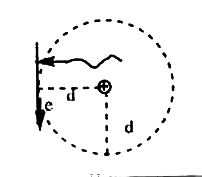A small metal plate (work function W) is kept at a distance d from a singly ionized, fixed ion. A monochromatic light beam is incident on the metal plate and photoelectrons re emitted. Find the maximum wavelength of the light beam so that some of the photoelectrons may go round the ion along a circle. Solution in Telugu
Electron is moving around the ion in a Circle of radius .d.. Centripetal force is provided by Electrostatic force
14πε0e2d2=mV2d,∴mV2=14πε0e2d
∴K.E=18πε0e2d .......(1)
But K.Emax=hcλ−W ......(2)
∴hcλ−W=e28πε0d
∴λ=hc8πε0de2+8πε0dW

Topper's Solved these Questions
- DUAL NATURE OF RADIATION AND MATTERBOOK - AAKASH SERIESCHAPTER - DUAL NATURE OF RADIATION AND MATTEREXERCISE - EXERCISE-I
66 Videos
- DUAL NATURE OF RADIATION AND MATTERBOOK - AAKASH SERIESCHAPTER - DUAL NATURE OF RADIATION AND MATTEREXERCISE - EXERCISE-I ASSERTION AND REASON
4 Videos
- CURRENT ELECTRICITYBOOK - AAKASH SERIESCHAPTER - CURRENT ELECTRICITYEXERCISE - EXERCISE - III
73 Videos
- ELECTRIC CHARGES AND FIELDSBOOK - AAKASH SERIESCHAPTER - ELECTRIC CHARGES AND FIELDSEXERCISE - Practice Exercise
57 Videos
Similar Questions
When stopping potential is applied in an experiment of photoelectric effect, no photocurrent is observed. This means that
View Solution(A) : Photoemission of electrons from a photosensitive surface is possible only if the incident radiation has a frequency above threshold frequency
(R): Unless the hv>hv0 = work function of metals, no photoemission of electrons is possible
View SolutionIn a hydrogen tube it is observed that through a given cross-section 3.13×1015 electrons persec. moving from right to left and 3.12×1015 protons per sec are moving from left to right. The electric current in the discharge tube and its direction is
View SolutionWat is the charge acquired by a body when one million electrons are transferred to it.
View SolutionA small metal plate of work function ϕ is kept at a distance r from a singly ionised, fixed ion. A monochromatic light beam is incident on the metal plate and photoelectrons are emitted. Find maximum wavelength of the light beam so that some of that electrons may go round the ion along a circle.
View SolutionThe work function for a metal is 4eV. To emit a photoelectron of zero velocity from the surface of the metal, the wavelength of incident light should be :
View SolutionA metal plate that emit photoelectrons under the influence of blue light, may not emit photoelectrons under the influence of red light. Explain
View SolutionLight of wavelength 3000Å is incident on a metal surface whose work function is 1 eV. The maximum velocity of emitted photoelectron will be
View SolutionLight of wavelength 4700Å is incident on a metal plate whose work function is 2 eV. Then maximum kinetic energy of the emitted photoelectron would be
View SolutionA metal plate of work function phi is illuminated by a monochromatic light beam of wavelength lamda A singly ionised ion is fixed at a distance r from the metal plate such that electrons emitted from the metal plate often revolve around it. Calculate the maximum possible value of lamda .
View SolutionIf work function of a metal plate is negligible, then find the K.E. of the photoelectrons emitted when radiations of 1000Å are incident on the metal surface
View SolutionA small metal plate of work function ϕ is kept at a distance r from a singly ionised, fixed ion. A monochromatic light beam is incident on the metal plate and photoelectrons are emitted. Find maximum wavelength of the light beam so that some of that electrons may go round the ion along a circle.
View SolutionLight of certain wavelength and intensity ejects photoelectrons from a metal plate. Then this beam is replaced by another beam of smaller wavelength and smaller intensity. As a result
View SolutionWhen the frequency of light incident on a metallic plate is doubled the KE of the emitted photoelectron will be
View SolutionLight of wavelength 3000Å is incident on a metal surface whose work function is 1 eV. The maximum velocity of emitted photoelectron will be
View Solution
